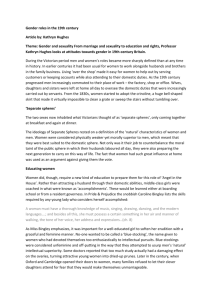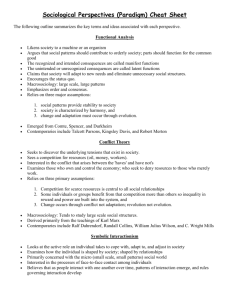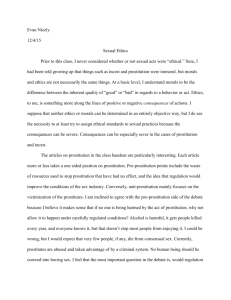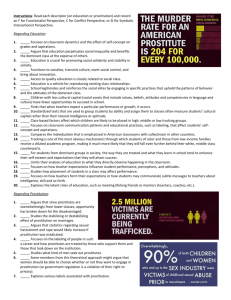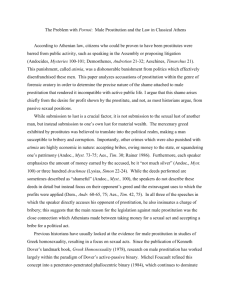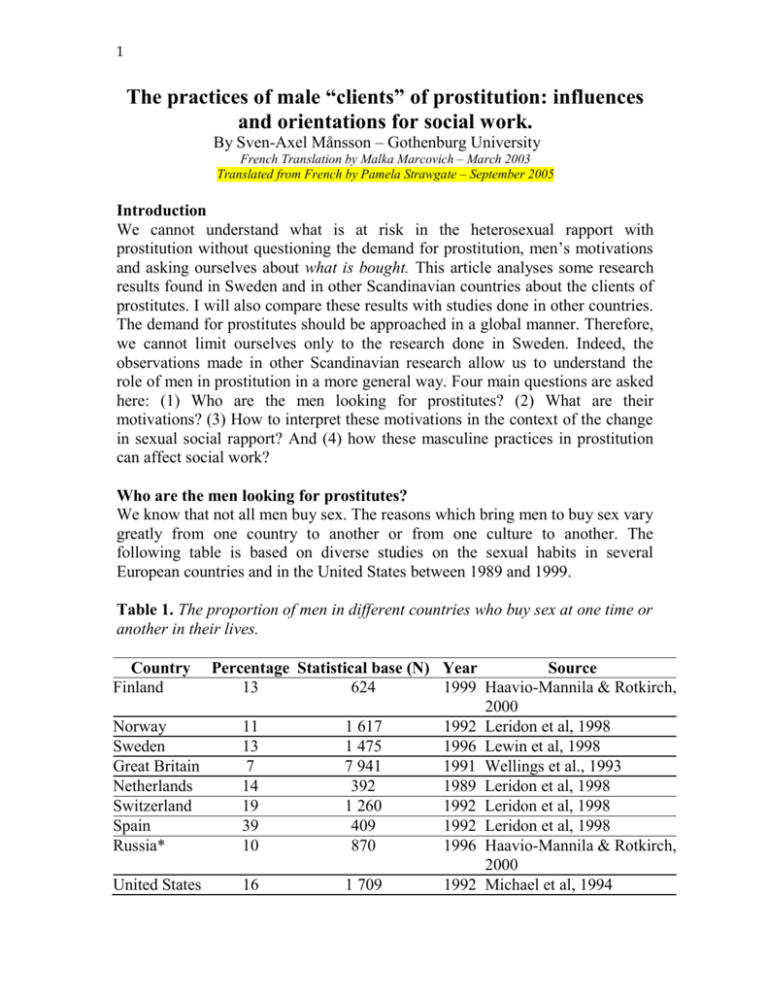
1
The practices of male “clients” of prostitution: influences
and orientations for social work.
By Sven-Axel Månsson – Gothenburg University
French Translation by Malka Marcovich – March 2003
Translated from French by Pamela Strawgate – September 2005
Introduction
We cannot understand what is at risk in the heterosexual rapport with
prostitution without questioning the demand for prostitution, men’s motivations
and asking ourselves about what is bought. This article analyses some research
results found in Sweden and in other Scandinavian countries about the clients of
prostitutes. I will also compare these results with studies done in other countries.
The demand for prostitutes should be approached in a global manner. Therefore,
we cannot limit ourselves only to the research done in Sweden. Indeed, the
observations made in other Scandinavian research allow us to understand the
role of men in prostitution in a more general way. Four main questions are asked
here: (1) Who are the men looking for prostitutes? (2) What are their
motivations? (3) How to interpret these motivations in the context of the change
in sexual social rapport? And (4) how these masculine practices in prostitution
can affect social work?
Who are the men looking for prostitutes?
We know that not all men buy sex. The reasons which bring men to buy sex vary
greatly from one country to another or from one culture to another. The
following table is based on diverse studies on the sexual habits in several
European countries and in the United States between 1989 and 1999.
Table 1. The proportion of men in different countries who buy sex at one time or
another in their lives.
Source
Percentage Statistical base (N) Year
13
624
1999 Haavio-Mannila & Rotkirch,
2000
Norway
11
1 617
1992 Leridon et al, 1998
Sweden
13
1 475
1996 Lewin et al, 1998
Great Britain
7
7 941
1991 Wellings et al., 1993
Netherlands
14
392
1989 Leridon et al, 1998
Switzerland
19
1 260
1992 Leridon et al, 1998
Spain
39
409
1992 Leridon et al, 1998
Russia*
10
870
1996 Haavio-Mannila & Rotkirch,
2000
United States
16
1 709
1992 Michael et al, 1994
Country
Finland
2
* The Russian statistics only concern the city of Saint Petersburg.
This table shows that Spanish men are the most frequent “buyers of sex,”
practically four out of ten Spanish men (39%) have bought sex at one time or
another in their life. British men have the least incidence of buying sex (7%).
The proportion of sex buyers seems approximately identical in the three
Scandinavian countries (Finland, Norway, and Sweden); a little more than one
out of ten men have paid for sex at some time in their life. Curiously, the Dutch
results (14%) are relatively low when we consider the commercial development
of sex in this country and its liberal official approach. A possible explanation
would be that the majority of sex buyers in this country would be foreign
visitors, who cannot be reflected in this statistical research done at a national
level. It should be noted however that the Dutch and Spanish results, (as well as
those of Finland and Russia) remain uncertain being given the relatively weak
statistical base.
Aside from these imprecise statistics, we can in any case question their
reliability for several reasons. The act of paying for sex is considered in many
countries as a transgression of norms that people prefer to hide from their
entourage. We find an interesting example of this phenomenon in a study done
on 661 German-speaking men on vacation in Thailand, the Philippines, the
Dominican Republic, Kenya and Brazil. All the men questioned had in effect
recognized having had sexual relations with local women. Even though the
researchers classified them in the category of “sexual tourists,” these men did
not at all identify themselves in these terms. Do they probably fear a strong
public condemnation of sexual tourism, because the majority of men (almost
80%) reject this terminology (Günther 1998:71)? These men identified instead
the relationship with these women to what Cohen calls “open-ended
prostitution,”1 a relation which frequently starts with an exchange of money for
a sexual service, and which later, during a trip by the man to the country,
“develops” into a “prolonged, diffuse and more personalized relationship which
includes both emotion and economic interest” (Cohen 1996:275; also see Bang
Fossum 2001). Also, certain men who pay for sex do not have a positive and
strong sexual image of themselves. Recognizing for yourself and for others that
one “has a need” to go see prostitutes may be felt as downgrading in relation to
sexual norms. But the opposite is also true. Any feeling of shame vested in the
fact of going to see prostitutes is also subordinated to another norm of masculine
domination, that of having multiples sexual experiences. Thus, the Swedish
study showed that the experience of paying for sex is predominant in men who
had already had numerous sexual partners (Månsson 1998:242). This reality
1
” une finalité prostitutionnelle ” in French
3
contradicts the popular idea in which the client is a “lonely” man motivated by
“sexual needs.” In another similar North American study, it was established that
clients were more inclined than other men to affirm that they have had more than
one sexual partner for the elapsed year, 59% against 19%. (Monto 2000:72)
It must be noted here that the social conditions at different periods of history
mold the multiple expressions and forms of prostitution. Prostitution activity
continually changes. New forms of contact between buyers and sellers are
developing, which has an impact on the number of men who get involved with
prostitutes. Today, prostitution is an integral part of the expansion of the sex
industry at a global level. The intensification of trans-national trade with a view
to prostitution is one of the integral elements of this commercial development.
On the one hand, there is a more or less organized importation of women from
third world and Eastern European countries for the brothels of rich western
countries. On the other hand, sex buyers from rich countries are transported in a
more or less organized manner to the poor regions of the world. When Swedish
sex buyers were asked where they had had their last sex for money contact,
nearly 70% of them responded that it had taken place abroad, whether it was
during their vacation, their work, or a business trip (Månsson 1998:243).
The development of “computer pornography,” the purchase and the sale of
sexual services on the Internet constitutes another recent change in the
structuring of the global sex industry. There is no doubt that the introduction of
this new technology increased the availability of sex for sale. Today, we have
little information on the way that this new technology affects the constancy and
the structure of the demand. However, as Donna Hughes points out in her
analysis of the sex industry: “In general, men remain secretive about their
exploitation of women and children. One of the success factors of the ‘online’ sex industry comes from the fact that men can now download pornography
and participate in prostitution acts from the privacy of their home or their
office.” (Hughes 2000:10). A recent study of Swedish Internet users who take
part in sexual activities showed that the most common and preferred activity of
men consists of looking at pornography (69%) (Cooper et al 2003). Moreover,
from the analysis of the content of approximately a thousand client emails (given
to the researchers by a woman who had decided to stop being a prostitute) it
appears that Internet clients are much younger and in a better socio-economic
situation than the clients of street prostitutes (Nordvinter and Ström 2000:37).
Why do men look for prostitutes?
Here, we are going to deepen what we know today about the reasons which
motivate men to buy sex. In most Scandinavian countries, studies have been
carried out on a qualitative base with in-depth client interviews.
4
--- end note start --Borg et al. 1981; Persson 1981; Månsson and Linders 1984; Varsa 1986; Prieur and Taksdal 1989; AnderssonCollins 1990; Hydén 1990; Lantz 1994; Sandell et al. 1996; Månsson 1998; Llyngbye 2000.
--- end note end ---
In analyzing these interviews and by focusing on the discourse of men who
explain why they look for prostitutes, it is possible to distinguish several types of
discourse. We can divide them into five major groups. These categories are not
mutually exclusive and in several cases, we found several themes in the same
interview.
The fantasy of “dirty Expression of contradictory feelings: curiosity, fascination
whore”
and disgust. The image of the “dirty whore” reinforces
sexual excitation.
Another type of sex The idea that certain forms of sexual rapport cannot be
experienced with women who are not prostitutes.
No other women
In reference to shyness, fear, an advanced age, a physical or
mental handicap. “There are no other women for me”.
Consumer of sex.
Images of sex as a saleable product.
Another type of
Images of the true feminine nature. Expressions of strong
woman.
antifeminist notions.
Before digging deeper into these different themes, we need to underline that
none of these categories explicitly refers itself to a reason linked to corporal
necessity for men, except that called Making one’s own sex market. How can we
explain this? Charles Winick made the same observation in his famous study on
American buyers of sex in the 1960s (Winick 1962). The interpretation Winick
gives to this is that the emotional meaning and that which undertones men’s
approach when visiting prostitutes would predominate over their real desire for a
sexual experience. We can also say that this desire for a sexual experience
manifests itself and translates into different ways when the men look at or speak
of the prostitute and themselves. This is the same as saying that what is really
happening during a visit to a prostitute is less important than the meaning which
the man attaches to it in his fantasy. This does not however mean that men do
not frequently have sexual needs or desire when they buy sex. This simply
shows that they do not speak about it when they explain the reasons for their
visit to prostitutes. They speak about other things, which reveal the way that the
demand is expressed. For example they often speak of “curiosity” or
“excitement”.
Theme 1: The fantasy of the “dirty whore”
An example is the fantasy of the “dirty whore.” For certain clients, in a distinct
and immediate manner, the image of the “whore” is sexually exciting. The
5
“whore” is perceived as a sexual animal, for violent desire and urgency, sexual
desire which here is often tied to secrecy and guilt. The “whore” represents an
aspect of a split feminine image, conveyed by patriarchal society. This image
motivates the way that men enter into a relationship with women in different
situations and not only in prostitution. De facto, the two images of the
“Madonna” and the “whore” turn women into objects. While the first is
respected, the second is scorned.
Embraced or scorned, there also exists the idea of seduction. Even though more
distant than “the Madonna,” “the whore” seems at the same time more accessible
as a source of dreams and erotic fantasies. Many men are motivated by curiosity
to have contact at least once in their life with a “whore,” to look at her, to
experiment with this type of sexual relation. Also, the environment of
prostitution provokes curiosity and excitement. In red-light districts or other
places where the sex industry exists, the environment of prostitution functions
like an “invitation” to sex. This is made obvious by the pornographic framework,
for example in sex clubs and porn boutiques which line the “promenades” of
large cities, or porn ads on Internet Websites. In no other place do we find
women who so openly display themselves sexually.
This experience of excitation is no doubt linked to the contradictory character of
the sex industry, at the same time repulsive and attractive. The disgust is an
element of self-contempt in the relationship that certain people have with the
notion of taboos and their secret drives. At the same time, it is known that the
secret attached to sexual fantasy adds excitement in many cases. There is a
temptation to dip into the hedonism of forbidden erotica. The British sociologist,
Julia O’Connell Davidson (1998:141) explains the way that certain clients
maintain contradictory feelings of seduction and self-contempt when they cast
the image of the “dirty whore” on the woman who makes herself publicly
available. This degradation of the prostituted woman allows the man to
distinguish himself from her and to free himself of guilt. As the opposite of her,
he remains socially respectable and morally innocent. The following extract,
written in an email by a Swedish man, underscores the extremely hostile attitude
vis-à-vis a woman who offers her services on the Internet. It is clear in this
message that the “dirty whore” is at the same time repulsive and sexually
exciting.
You dirty slimy whore!!! I hate you. The next time that I will visit Stockholm, I
will hunt you down and I will beat you up. Like that, you’ll never be able to fuck
again. You disgusting whore!!! If you were one of my acquaintances, I would
beat you up until your ass is in your face…Everybody like you should be killed!!!
Of course, I can imagine your panties, it would be great to jerk off inside
them…If I was you, I wouldn’t let people like me come into your apartment. So
6
be careful!! Don’t you have any pride? I pity you. At the same time, I could fuck
you in the ass with my foot. Ciao!
PS. You’d better not answer me…!!!
--- end note start --This annotation comes from a Doctoral thesis by Nordvinter and Ström (Department of Social Work, Gothenburg
University, 2000, p.35) who studied Internet clients of prostitutes. This letter is one of the 1200 letters from
clients which was given to the authors by a woman who had decided to leave prostitution.
--- end note end ---
Of course, it is impossible to judge the seriousness of this man’s threats to this
woman. But this example seriously underlines the danger in prostitution; and no
place is safe, not even the Internet, to hide from the intimidation and the
violence.
Theme 2: Another type of sex
The idea of sexuality with an experienced and smart woman, willing to perform
types of sexual acts that he would not ask of his wife or official partner, is often
part of men’s fantasies. More so, it is interesting to note here that certain men
openly ask for a different and more passive role with a prostitute than that which
they have in their regular relationships. In other words, the man buys himself the
right to be passive and to be “seduced” by a sexually aggressive “whore.” In a
study done by the American sexologist Martha Stein (1974) on the clients of
call-girls, it appeared that the act most requested of women was fellatio. Many
clients, in particular the oldest, said their dissatisfaction came from the refusal of
their wives to perform this type of act. The other most requested act was for the
woman to be on top of the man. According to Stein, approximately half of the
men took on a passive role, leaving the responsibility to take the initiative to the
prostitute. Certain man also pay prostitutes to be sexually dominated, assaulted,
humiliated, tyrannized or degraded in various ways. It seems then that men,
when it’s possible, prefer to abandon their socially constructed position of power
in order to adopt another which authorizes them to give up control and ignore the
demand for sexual performance.
At play here is a complex and contradictory game of power. The man here does
not dominate the woman in a visible way. Yet he uses his power to create a
situation where the traditional sexual roles are reversed. In reality, the woman’s
power which would be linked to her dominant position is only an illusion. It
goes without saying that it is the man’s wish to give up control. In reality the
woman’s value remains contingent on the fact that a “prostitute stays a
prostitute.” She doesn’t have real value as a human subject. In the eyes of the
client, her value stays, on the contrary, uniquely tied to her body and her sexual
7
performance. We can say that the client in fact dehumanized the prostitute and
refuses to see in her something other than her body and her sexual performance
(O’Connell Davidson 1998:150). However, it is probable that this vision will be
contested by the man himself, in particular by those who are involved in what
Cohen defines as open-ended prostitution. (See above). This type of relationship
presupposes a tacit agreement where both parties participate in creating a
“romantic” aspect of the relationship, and which conceal the economic and
commercial aspects of the transaction. (Bang Fossum 2001:72).
Theme 3: No other women
The ardour of desire for women in general, and not only prostitutes, remains the
most recurrent discourse in this theme. In this situation, it concerns men who do
not have relationships with woman and who consider that they have major
difficulties to come into contact with them. This observation comes from Martin
A. Monto’s North American study where the statistics suggest that certain men
who pay for sex say they have problems getting involved in conventional
relationships. “42% (out of 700 interviews, my commentary) recognize that they
are “shy and awkward” when thy try to start a relationship with women and 23%
underline their difficulties in meeting women who are not strippers or
prostitutes. » (Monto 2000:80).
The affirmation: “There are no other women for me” does not necessarily mean
that these men do not have the opportunity to meet women. This mostly refers to
men’s subjectivity and what they consider to be available in the sex industry.
However, O’Connell Davidson criticizes the line of thinking which envisions
prostitution as a form of sexual therapy or care. She explains that the fact of
presenting the prostitute like a “sympathizer” with a big heart authorizes the
client to pretend that it is solitude and not desire which pushes him to look for
prostitutes. “But behind this speech, the sexual scenarios generally have as much
to do with vengeance and control, as with any other client,” emphasizes
O’Connell Davidson (1998:152). Indeed, in his private fantasy world, the client
thinks that it is the prostitute’s duty to make him perform well and to help bring
him up to a position of control. The client simply transfers his need to perform
on her. This is one of the keys of his vulnerability, but also of his potential
danger. To make the prostitute responsible for his performance (and a sexual
release) signifies that he also projects his possible impotence on to her. It is here
that this position of power becomes dangerous for her. A man who is not able to
have an erection can become dangerous. A strong tie between sexual impotency
and violence exists in these cases. A man who considers himself excluded, not
only from the sexual act, but in a deeper way from an experience of an able man
who feels alive, can very well lead to the prostitute’s murder (Månsson
1988:39).
8
Theme 4: Consumer of sex
Prostitution is a practice which mainly concerns men. In order to understand
what men are looking for in prostitutes, it is necessary to take masculine
sexuality and human relations into account. Sexuality and the relations
between the sexes are socially constructed which explains that the way men
live and speak about prostitution remains dependent on social and economic
particularities prevalent in a given society. In this way, there exists today a
group of clients, mainly composed of young men for whom the representation
of social relations of sex and sexuality is modeled by the images massively
produced by our modern society in pornography, publicity, and TV
entertainment programs. For these men, anything is possible, including in the
domain of sexuality. This approach creates solid bases for prostitution because
in prostitution, the possibilities seem infinite, once the consumer accepts
paying. This leads to an essentially mercantile vision of sexuality, where sex
is comparable to a consumer product rather than an intimate relationship. Sex
is, before anything else, perceived as a physical necessity which requires
attention at regular intervals, like a recurrent need to “clean the pipes.” This
approach is not very new from an historical perspective. This theme in fact
returns to the archaic patriarchal ideology which defends heterosexual
prostitution as a natural and inevitable phenomenon. In this ideology,
prostitution is perceived as an old institution and as the oldest profession of
women. In the last capitalist era, this vision found its typical expression in
what Blanchard calls McSex, which returns to the idea that it is necessary to
buy a sexual partner, anywhere where she is available. According to a man
interviewed, going to a prostitute is “like going to McDonalds;” most of the
people are looking for a good, fast meal at a good price. It’s satisfying, it’s
fattening, and after, you get out of there quickly” (Blanchard in Monto
2000:80).
Norwegian sociologists Prieur and Taksdal (1989; 1993) call sex buyers the
cheaters. They affirm that the cheaters are “the most modern players of the
sexual game”, men who refuse meetings with women due to fear of losing
themselves in an egalitarian relationship. They feel “dissatisfied but safe.” For
fear of being seduced, the cheater/buyer of sex takes refuge in a world he can
control thanks to the power of money. These men complain about women who
would expect too much from them. They are afraid of not being capable of
meeting all the expectations of their family, employers and society. They are
tired of being responsible. In prostitution, no expectation exists. Men are free
to do as they please after they have paid. No emotional investment or ties
exist.
Theme 5: Another type of woman
9
For many European and North American men, access to the equality of rights
for women is felt as a loss of masculine supremacy. Certain men react
vigorously to this, showing regressive and anti-feminist attitudes. They do not
accept these changes and hang on to the old notions of masculine domination
over women. We should interpret these reactions as the expression of a true
sense of loss, which is translated into a need to compensate or to divert it by
aggressiveness toward women in various contexts.
According to me, we should be concerned about the compulsive sexual
odyssey of many men in prostitution to the light of these changes. In the same
way, the increase in the demand for women victims of the white slave trade
and imported must also be included in this perspective. This become clear
when we look at the marketing of prostitution, in which racist and ethnic
stereotypes play an important role. Asian women are presented as loving and
submissive, African women as savages and Latin-American women as free
and easy (Månsson 1995). It is not complicated to visualize the way that these
stereotypes develop in the discourse of men and their fantasies about “another
type of woman,” which would compensate for the decrease of their masculine
sexual power in their daily relationships. This is what Julia O’Connell
Davidson also concludes in her study on sexual tourism. “Sexual tourists
…are certainly not the only ones to feel this turmoil, but they distinguish
themselves by the fact that they attach an immediate erotic meaning to this
loss” (O’Connell Davidson 2001:13). These men project on the women that
they meet abroad the image of natural femininity. According to them, they are
close to “the natural state” (or true femininity), which implies that they
recognize the essential differences between the sexes. They have accepted
their role « natural from birth » as comfort for masculine sexual needs.
According to O’Connell Davidson this vision should necessarily be a concern
in the context of anxiety and of discontent that certain men feel in this “new”
political order in the occidental world. (ibid:14).
I also share this analysis. There also exist other expressions of this modern
form of prostitution which springs from this way of thinking. We can observe
them in the interconnection held by homosocial ties which unite male clients
in the development of “communities” on the Internet. These men find each
other on certain Web sites to exchange and to sell information on their
experiences, their contacts and transactions with prostitutes in their country or
abroad. Some of these associations make us think of old fraternal lodges
whose function was to foster friendships, business, politics and leisure
activities while at the same time supporting and reproducing the powerful
myth that masculinity is forged in the exclusive company of men (Tosh,
1994). In this sense, the modern version of these homosocial alliances on the
10
Internet should be dreaded as a nostalgic resurrection of human privilege,
which justifies the free access and the use of prostitutes.
What are the implications for social work?
After having analyzed men’s discourses on their motivations for buying
sex, appears clearly in what this action makes sense at several levels,
whether it is in an individual or social dimension. Complex interactions
between these dimensions must be taken into consideration in order to
understand this phenomenon in its global nature. At the psychological or
social level, this respond to the demands of different sexual satisfaction
and/or would bring solutions to the problems that confront men in their
relations with women who are not prostitutes. We must however
emphasize that women in the same situation do not choose this solution.
The use of prostitution is an essentially masculine practice. To
understand what these men are looking for with prostitutes, it is
necessary to take into account masculine sexuality and social sexual
relationships.
Reducing the demand for prostitution supposes both individual and societal
change. Until today, it has been women who have been at the head of the line in
the battle for these changes. But for a radical change to happen, the participation
of men becomes necessary. The fundamental question that we should be asking
today is the following: Is there a sufficient number of men who are ready to
commit themselves to blocking sexist policies and to question the beliefs on the
differences between the sexes, the idea of masculine sexual “needs,” and the
stigma which weighs on “devouring” feminine sexuality? By observing today’s
situation in Europe and in North America, we find that there exist dynamic
relations between the old and the new images of masculine life at all levels of
society: in professional and family life, and in the domain of love and sexuality.
Some men are committed to developing a larger repertoire of their life in social,
emotional and sexual domains. Also, there simultaneously exist tendencies to
consolidate traditional models through regarding the opposite sex as objects. It is
in this context that aggressive anti-feminist attitudes arise and violence against
women develops. These attitudes are reinforced by most of the cultural
mechanisms which surround our daily life in our contemporary society. These
mechanisms are not only institutionalized by the global sex industry which
includes prostitution, white slave trade and other forms of sexual exploitation,
but also by the State and by the market. That is why we must deal with this
industry as a priority.
We need a consciousness raising campaign and a long-term educational program
in order to fundamentally reexamine the question of sexuality, human relations
and prostitution. This type of campaign should be geared toward children and
11
adolescents in particular (Anderson & O’Connell Davidson 2003). Certain
people consider however that educational campaigns are not enough to stop the
exploitation by men of women in prostitution. This situation requires penal
measures like laws that forbid the purchase of sexual services. Such a law was
introduced in Sweden in 1999.
--- end note start --This law went into effect on January 1, 1999 (1998:408). It says that a « person who obtains occasional sexual
relations in exchange for payment must be pursued for the purchase of sexual services with a fine or a maximum
six-month prison term. The attempted purchase of sexual services is punished in Chapter 23 of the Swedish Penal
Code.
--- end note end ---
. This relatively small change in legislation has brought about intense debates
inside and outside the country. We can propose several reasons for this reaction.
The first is that this law was proclaimed during a period when very stormy
debates about prostitution were already going on at an international level,
debates mainly about public control and regulation of prostitution. The Swedish
initiative to end “the oldest profession” by penalizing the purchase of sexual
services has run up against mockery and consternation from those who push for
prostitution and commercial sex to be considered like a job and a legitimate
industrial sector in society. Those who, on the contrary consider that prostitution
is an expression of masculine exploitation and violence against women, consider
this law as a major rupture and an important step toward a more egalitarian
society.
Social workers have traditionally been skeptical about the use of repressive
measures as a means to change people’s attitudes and their behavior. One of the
arguments used against this strategy by certain members of this profession in
Sweden was that this law would be counterproductive and would force as many
clients as prostitutes to enter “into clandestineness,” which would have the effect
of undermining the efforts of social workers to help them and influence
behaviors. Those on the other hand who were in favor of the law pointed out the
positive consequences, notably the fact that the anonymity of men in prostitution
would thus be removed, and that the client would all of a sudden be forced to be
confronted by the social and human implications of his actions. They believe
that in the short-term, there would probably be an increase of frustration and
restrictions linked to the notions of comfort and privileges inherent to men. In
the long-term on the other hand, this would possibly bring about the end of
relations with women based on “cheating.” This could, in reality, provoke a
masculine awareness on the consequences of the purchase in prostitution and
signify a release for the men who decide to take up the challenge of a socially
egalitarian relationship with their partners.
12
But this type of change cannot happen by itself. This presupposes an active
intervention, which does not use only legal measures to prevent men from going
to see prostitutes, but also social support and treatments. We can affirm this
because we need to indicate that there exist mainly two distinct groups of men
who buy sex. We can call one of these groups occasional buyers. These are men
who buy sex on a few occasions during their entire life. This group is the most
responsive to legal measures. Most of the time, the risk of public proceedings
has a discouraging impact on their behavior.
We will call the other group habitual buyers. This group concerns men who
regularly go and see prostitutes during more or less long periods of their adult
life. They are very numerous but “consume” a large number of contacts with
prostitutes (Månsson 1998). The sexual life style of this group of clients is
analysed by Sandell et al (1996). Their relationship to women is described as
“sexualized” and “profoundly perturbed.” Some of them suffer from serious
problems of sexual dependence. The excessive commitment to prostitution and
pornography creates many difficulties including financial, work, relationships as
well as personal. “The profound disturbance” also refers to those who project
their psychological problems on women, by using a more or less excessive
violence to humiliate and degrade them. This group is undoubtedly not very
responsive to legal measures, which means that fines or prison do not prevent
them from buying sex time after time. Working with these men and treating their
problems is certainly the greatest challenge of social work.
For several years, there has existed a type of experience of social assistance
directed at men in Sweden whose results are promising (Hedlund 2002). The
majority of men who have used the opportunity to speak to a psycho/social
counselor have described their problem as being “out of their control”, “like a
fish”; “I’m always thinking about sex” etc. Certain of them had been directed to
long-term psychotherapeutic treatments. Whatever the inherent problems of each
case, we can observe a feeling of liberation in all these men after having broken
the silence about this behavior which brought about feelings of excessive guilt,
the loss of relationships with others and other social and psychological problems.
For these men, returning to their old life seems to them to be returning
definitively to an obscure tunnel.
Conclusion
From an historical point of view, the attention given to clients, whether it is from
a research point of view or from social and penal practices, constitutes a major
change of perspective. We must recognize that the role of the client in the sex
industry has rarely been addressed. In the past lived the fundamental idea that a
group of women should be accessible for men’s sexual needs. They existed to
13
satisfy men’s desire. The image of the “whore” remained the most somber vision
that men had of femininity. Linked to seduction, contempt and disgust, she stays
uniquely defined by a sexuality that one gets in exchange for money. Such
emotionally charged images have never existed about the male consumer. He has
always remained anonymous and invisible. The only image of the client which
prevails is built around a rigid and one-dimensional vision of a biologically
determined masculine sexuality, stimulated by a permanently aroused desire,
which nothing can change. This approach denies the fact that sexuality is
socially and culturally constructed, and that it is only in this perspective that we
can understand it. Research done on the sexual attitudes of men in different
countries shows that the scale of clients goes from a small percentage in one
country to 40% in another. We can thus conclude that in order to understand the
reasons for which men look for prostitution, it is necessary to consider the
specific cultural and historical circumstances surrounding male sexuality. And
just as these circumstances can evolve, masculine sexuality and the demand for
prostitution can as well.
It is obvious that an effective change in this domain requires us to radically
reconsider the responsibility of men in prostitution. For this, it is necessary to
define prostitution as an integral part of the masculine question. Prostitution
concerns masculine sexuality and not feminine sexuality. Without the male
demand for prostitution, there wouldn’t be any women prostitutes.
14
Bibliography
Anderson, B. & O’Connell Davidson, J. (2003): The Demand Side of
Trafficking? A Multi Country Study, Stockholm: Foreign Ministry, en
impression
Andersson-Collins, G. (1990): Solitärer: En rapport om prostitutionskunder,
Stockholm: FOU-byrån, Rapport No. 124.
Bang Fossum, M. (2001): “-men sådan er min kæreste ikke…” Om mandlige
turisters forhold til prostituerede kvinder i et thailandsk feriemål, Kvinder,
Køn & Forskning, No. 3
Borg, A. et al. (1981): Prostitution: Beskrivning, analys, förslag till åtgärder,
Stockholm: Publica (Liber)
Cohen, E. (1996): Thai Tourism – Hill tribes, Islands and Open-Ended
Prostitution, London: White Lotus Press
Cooper, A., Månsson, S-A., Daneback, K., Tikkanen, R., & Ross, M. (2003):
Predicting the future of Internet sexuality: The case of Sweden, Journal of
Sexual and Relationship Therapy (en presse)
Günther, A. (1998): ‘Sex tourism without sex tourists!’ in Cognizant
Communication Offices, Sex Tourism and Prostitution: Aspects of Leisure,
Recreation, and Work, New York: Cognizant Communication Cooperation.
Haavio-Mannila, E. & Rotkirch, A. (2000): Gender liberalisation and
polarisation: Comparing sexuality in St.Petersburg, Finland and Sweden, The
Finish Review of East European Studies, Vol. 7, No. 3-4
Hedlund, E. (2000): KAST-projektet – rådgivningsverksamhet för sexköpare,
Göteborgs stad Centrum: Cityenheten
Hughes, D.M. (2000): ‘The Internet and sex industries: Partners in global
sexual exploitation’, Technology and Society Magazine, Spring 2000
(prochainement publié)
Hydén, L-C. (1990): De osynliga männen. En socialpsykologisk studie av
manliga prostitutionskunder, Stockholm: FOU-byrån, Rapport No. 122
Lantz, I. (1994): Torsken i fittstimmet. Om prostitutionskunder i Stockholm,
Stockholm: Citysektionen, Socialtjänsten
Lewin, B., ed. (1998): Sex in Sweden. On the Swedish Sexual Life,
Stockholm: The National Institute of Public Health
Leridon, H., Zesson, G., & Hubert, M. (1998): The Europeans and their
sexual partners, in M. Hubert. N. Bajos and T. Sandfort (eds) Sexual
Behaviour and HIV/AIDS in Europe, London: UCL
Lyngbye, P. (2000): Mænd der betaler kvinder – om brug av prostitution,
Roskilde: Roskilde Universitetsforlag
Michael, R.T., Gagnon, J.H., Laumann, E.O., and Kolata, G.(1994): Sex in
America: A Definitive Survey, Boston: Little, Brown and Company
Monto, M.A. (2000): ‘Why men seek out prostitutes’. In R. Weitzer (ed.), Sex
for Sale. Prostitution, Pornography and the Sex Industry, London: Routledge
15
Månsson, S-A. and Linders, A. (1984): Sexualitet utan ansikte. Könsköparna,
Stockholm: Carlssons (also published in a shorter version in English,
Månsson, S-A: The Man in Sexual Commerce. Lund: Lund University,
School of Social Work, Report 1988:2; also in French by the samae author:
‘L’homme dans le commerce du sexe’. In P. Van der Vorst and P. May (eds),
La Prostitution – quarante ans après la convention de New York, Bruxelles:
Bruylant, 1992)
Månsson, S-A. (1995): ‘International prostitution and traffic in persons from
a Swedish perspective’. In M. Klap et al. (eds): Combatting Traffic in
Persons, Utrecht: SIM Special No. 17
Månsson, S-A. (1998): ‘Commercial Sexuality’. In B. Lewin (ed.), Sex in
Sweden. On the Swedish Sexual Life, Stockholm: The National Institute of
Public Health
Nordvinter, AL. and Ström, A. (2000): Torsk på nätet, Göteborg:
Institutionen för socialt arbete
O’Connell Davidson, J.
(1998): Prostitution, Power and Freedom,
Camebridge: Polity Press
O’Connell Davidson, J. (2001): The Sex Tourist, The Expatriate, His ExWife and Her ‘Other’: The Politics of Loss, Difference and Desire,
Sexualities, vol. 4, no. 1
Persson, L. G.W. (1981): Horor, hallickar och torskar, Stockholm: Norstedts
Prieur, A. and Taksdal, A. (1989): Å sette pris på kvinner: Menn som kjøper
sex, Oslo: Pax
Prieur, A. and Taksdal, A. (1993): ‘Clients of prostitutes - sick deviants or
ordinary men? A discussion of the male role concept and cultural changes in
masculinity’, NORA, No 2, p. 105-114
Sandell, G. et al. (1996): Könsköparna. Varför går män till prostituerade?
Stockholm: Natur och Kultur
Stein, M.L. (1974): Lovers, Friends, Slaves… The 9 Male Sexual Types.
Their Psycho-Sexual Transactions with Call Girls, New York: Berkely Pub.
Co and P.T. Putnam & Sons
Tosh, J. (1994): What Should Historians do with Masculinity? Reflections on
Nineteenth-century Britain, History Workshop Journal, Issue 38
Varsa, H. (1986): Prostitutionens osynliga aktörer: kunderna, Helsingfors:
Kvinnoforskningsstenciler, No. 5
Wellings, K. et al. (1994): Sexual Behaviour in Britain. The National Survey
of Sexual Attitudes and Lifestyles, London: Penguin Books
Winick, C. (1962): Prostitutes’ Clients’ Perception of the Prostitute and of
Themselves, International Journal of Social Psychiatry, vol 8, no. 4


